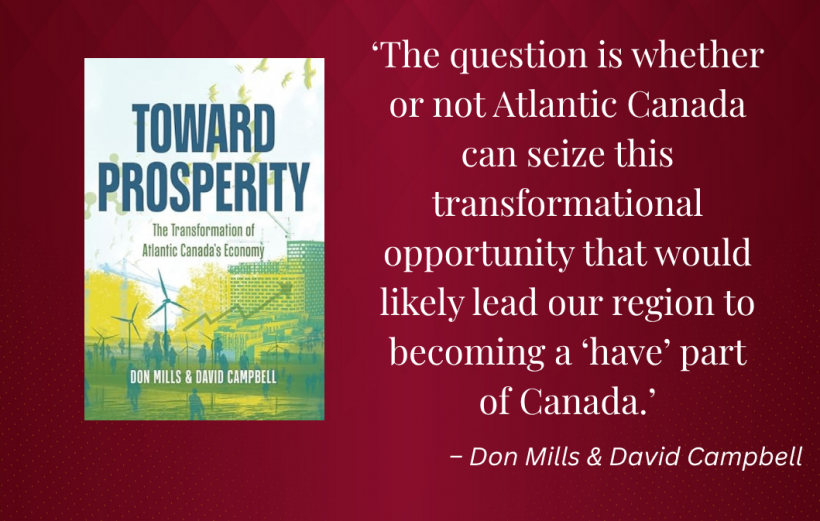For the first two-thirds of Toward Prosperity, the reader could be forgiven for thinking they’d picked up the wrong book.
In the title, this superb new analysis of the Atlantic Canadian economy by economist David Campbell and retired pollster Don Mills promises a path to affluence. Even the subtitle, The Transformation of Atlantic Canada’s Economy, makes it clear that things are changing in a region that stubbornly remains a have-not corner of Canada.
But the place they describe in the first 200-or-so pages of their book seems neither prosperous nor transformed. The reader is left to wonder what sorcery they’ll conjure to bring about the conversion of this – dare I say it? – backwater.
But Campbell and Mills deliver, laying out a plausible plan for the four eastern provinces to reverse a century and a half of economic under-performance. They offer a road map, but not a guarantee that policy makers will follow the route they’ve chosen. There would be difficult, indeed unpopular, choices.
Campbell and Mills are best known these days for their Insights podcast, in which they discuss economic and policy issues with a range of politicians and business leaders. (I’ve appeared to discuss Entrevestor’s startup data.) Campbell, the CEO of Moncton-based Jupia Consultants, is also the author of the excellent “It’s the Economy, Stupid!” blog. Mills retired after selling his business Corporate Research Associates, now Narrative Research, in 2018.
They have transformed the content of their podcast, backed up with a library of economic statistics, into a book that will soon be found dogeared and bookmarked on the nightstands of every policy wonk in the region. It’s peerless in its analysis of the economic forces at play in Atlantic Canada.
Pulling no punches, they say there are two main factors (whether they’re causes or symptoms isn’t clear) determining the economic underperformance of the region. Atlantic Canada has more people working for government than other parts of Canada; and a greater proportion of the population lives in rural areas than is the case west of Gaspé Bay. (Some 40 percent of Atlantic Canadians live in rural areas, far greater than the national mark of 15 percent.)
The authors are methodical in detailing why this matters. Obviously, a workforce dedicated mainly to government is expending a jurisdiction’s wealth, whereas private sector workers are generating wealth. The problem with having so much population in rural areas is that a broad swath of the workforce depends on seasonal labour, supplemented by employment insurance, or EI. This deprives rural areas of steady, full-time workers, which makes long-term investment and economic strategy difficult.
These are just two of the reasons that Atlantic Canada’s GDP has gone from 6.8 percent of the Canadian economy in 1983 to 5.3 percent 40 years later. It also helps to explain why Atlantic Canada’s employment growth has lagged the national rate by 48 percent in the ten years to 2023.
Toward Prosperity is absolutely packed with this sort of economic data (too much to relay here) that backs up this analysis. It is especially strong in matters of population and demographics. The authors are sometimes repetitive, but they give a clear indication of how and why our region has underperformed.
The solution to these economic ills, as Mills and Campbell see it, is a multi-faceted approach supported by the central pillar of energy development. The opportunity of offshore wind power is a big part of it, but so is nuclear power in New Brunswick and hydrogen production in Nova Scotia and Newfoundland and Labrador. The authors call for a full buy-in to energy mega-projects that, while requiring billions of dollars of capital, have the power to transform the regional economy. “The question is whether or not Atlantic Canada can seize this transformational opportunity that would likely lead our region to becoming a ‘have’ part of Canada,” they write.
The economic medicine includes implementing a more competitive tax structure, and establishing “economic hubs” in medium-sized towns throughout the region. And Mills and Campbell call for continuing support for entrepreneurship and the startup community.
It’s interesting to note – given that I’m writing in a startup publication – that startups in this book are given far less attention than energy megaprojects. Startups have been all the rage in economic development circles for the better part of a decade, which explains the proliferation of business accelerators and incubators. It seems we may now be entering a phase in which wind power and hydrogen production will capture the attention.










